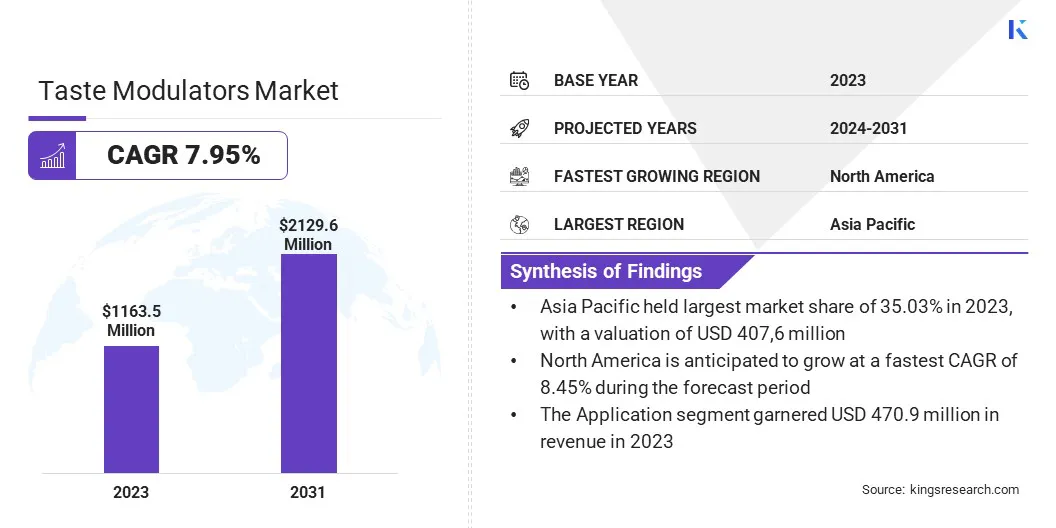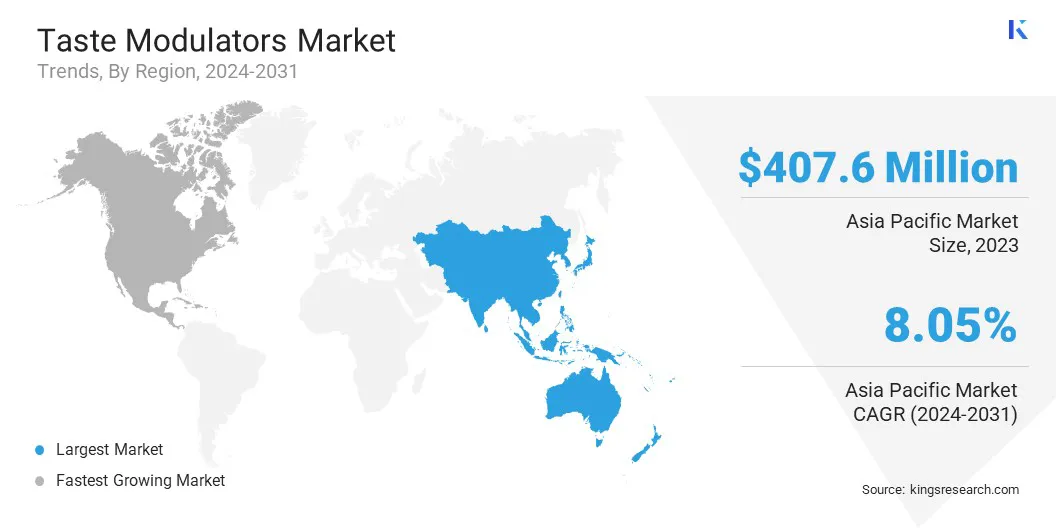Market Definition
The market focuses on ingredients that enhance, suppress, or modify taste perceptions in food and beverages. These compounds help improve flavor profiles while reducing the use of sugar, salt, and artificial additives, aligning with consumer demand for healthier products.
Key application areas include dairy, confectionery, beverages, and savory foods. The market continues to evolve as companies adapt to changing dietary preferences and regulatory requirements.The report highlights key market drivers, major trends, regulatory frameworks, and the competitive landscape shaping the industry’s growth.
Taste Modulators Market Overview
The global taste modulators market size was valued at USD 1163.5 million in 2023 and is projected to grow from USD 1246.7 million in 2024 to USD 2129.6 million by 2031, exhibiting a CAGR of 7.95% during the forecast period.
The market is benefiting from AI and ML technologies to optimize sweetness and reduce sugar content in food and beverages. These innovations enable the development of healthier, lower-calorie products while maintaining desirable flavor profiles, meeting consumer demand for healthier alternatives.
Major companies operating in the taste modulators industry DSM, International Flavors & Fragrances Inc., Givaudan, Kerry Group PLC, Ingredion Incorporated, Symrise, Tate & Lyle PLC, Takasago International Corporation, Corbion, The Flavor Factory, Döhler GmbH, Flavorchem Corporation, Hasegawa Co., Icon Foods, and ADM.
The market is experiencing increased relevance in response to the rising adoption of plant-based diets. As consumers continue to shift toward plant-based alternatives for health, environmental, and ethical considerations, the demand for dairy and meat substitutes has grown significantly.
These alternatives often require enhancement to replicate the taste and texture of conventional animal-based products. Taste modulators play a critical role in improving the sensory attributes of plant-based formulations. This transition is prompting manufacturers to invest in the development of more advanced and effective flavor modulation solutions to meet changing consumer expectations.
- In October 2024, MANE launched its SENSE CAPTURE Precision Taste Modulation program to enhance plant-based dairy products, addressing consumer demand for sustainable and healthy alternatives by reducing bitterness and off-notes while improving overall mouthfeel and taste.

Key Highlights:
- The global taste modulators market size was recorded at USD 1163.5 million in 2023.
- The market is projected to grow at a CAGR of 7.95% from 2024 to 2031.
- Asia Pacific held a market share of 35.03% in 2023, with a valuation of USD 407.6 million.
- The sweet segment garnered USD 447.4 million in revenue in 2023.
- The food segment is expected to reach USD 852.8 million by 2031.
- North America is anticipated to grow at a CAGR of 8.45% during the forecast period.
Market Driver
Sugar Reduction and Sweetness Optimization
The market is driven by rising health concerns and increasing efforts to reduce sugar intake in food and beverages. Manufacturers are focusing on optimizing sweetness using natural sweeteners like stevia, monk fruit, and allulose, which often require modulators to improve their taste and sensory appeal. Taste modulators play a key role in masking off-notes and enhancing the overall flavor profile of reduced-sugar products.
- In January 2025, FlavorSum launched FlavorSum Modulate, a portfolio of flavors with modulating properties (FMPs) that help mask bitterness, enhance mouthfeel, and mitigate off-notes in food and beverage products. The range includes solutions for alcohol, bakery, beverage, cannabis, and dairy and non-dairy applications, supporting brands’ efforts in functional and low-sugar product development.
Market Challenge
Limited Consumer Awareness and Education
Limited consumer awareness represents a notable challenge in the taste modulators market. Many consumers have limited understanding of the mechanisms and benefits of taste modulators, such as their ability to reduce sugar and salt content while preserving flavor.
This lack of familiarity may contribute to consumer reluctance to adopt these products, particularly in markets where traditional ingredients like sugar and salt are firmly established in regular consumption patterns.
To address this challenge, companies are investing in educational campaigns, implementing clear labeling strategies, and collaborating with health professionals. These efforts aim to improve consumer understanding of taste modulators and build greater trust in products that use these ingredients.
Market Trend
Predictive Flavor Modeling Through AI and ML
The market is increasingly benefiting from the integration of Artificial Intelligence (AI) and Machine Learning (ML). AI-driven algorithms are utilized to analyze consumer preferences and predict optimal flavor profiles, allowing manufacturers to create tailored taste solutions.
AI is helping researchers discover new and more effective compounds that can enhance or modify flavors to meet consumer preferences. Additionally, ML models enhance the formulation process, improving both efficiency and cost-effectiveness. These technologies also play a critical role in refining the sensory experience, enabling real-time adjustments to flavor interactions for better consumer satisfaction.
- In January 2025, researchers from the University of China integrated artificial intelligence into food flavor science to enhance precision in taste profiling and compound identification. By leveraging AI algorithms, the team streamlined the formulation of flavor modulators that align with evolving consumer preferences for low-sugar, plant-based, and personalized nutrition solutions, supporting innovation across the market.
Taste Modulators Market Report Snapshot
|
Segmentation
|
Details
|
|
By Type
|
Sweet, Salt, Fat
|
|
By Application
|
Food, Beverages, Pharmaceuticals
|
|
By Region
|
North America: U.S., Canada, Mexico
|
|
Europe: France, UK, Spain, Germany, Italy, Russia, Rest of Europe
|
|
Asia-Pacific: China, Japan, India, Australia, ASEAN, South Korea, Rest of Asia-Pacific
|
|
Middle East & Africa: Turkey, U.A.E., Saudi Arabia, South Africa, Rest of Middle East & Africa
|
|
South America: Brazil, Argentina, Rest of South America
|
Market Segmentation:
- By Type (Sweet, Salt, Fat): The sweet segment earned USD 447.4 million in 2023 due to the growing demand for sugar reduction in food and beverages without compromising taste.
- By Application (Food, Beverages, Pharmaceuticals): The food segment held 40.47% of the market in 2023, due to the rising consumer preference for healthier food choices and the widespread use of taste modulators in product reformulation.
Taste Modulators Market Regional Analysis
Based on region, the global market has been classified into North America, Europe, Asia Pacific, Middle East & Africa, and South America.

Asia-Pacific Taste Modulators market share stood around 35.03% in 2023 in the global market, with a valuation of USD 407.6 million. Market growth in the region is primarily driven by rising health awareness and increasing regulatory measures aimed at reducing sugar content in food and beverages.
As a result, manufacturers are adopting taste modulators that support sugar and salt reduction while preserving overall flavor integrity, thereby driving market growth.
- In November 2023, IFF launched a food and beverage co-creation center in Seoul, South Korea, to meet the growing demand for health-focused and functional products. The facility emphasizes flavor modulation and includes a Ultra-High Temperature pilot plant to develop low/no-sugar and high-protein offerings.
The North America region is poised for significant growth at a robust CAGR of 8.45% over the forecast period. The taste modulators industry in this region is poised for significant growth due to The rising demand for healthy and low-calorie foods is driving the adoption of taste modulators in the North American market, as consumers increasingly seek products that deliver flavor without added sugars, fats, or salts.
Additionally , innovation within the food and beverage industry is accelerating the development of new taste modulation technologies to enhance flavor profiles and mask undesirable tastes, particularly in plant-based and functional foods. This combination of health-conscious consumer preferences and industry innovation is fueling robust growth in the market.
Regulatory Frameworks
- The U.S., market is governed by the Food and Drug Administration (FDA), which ensures the safety and efficacy of ingredients used in food and beverages. The FDA regulates the approval of food additives, including taste modulators, by requiring manufacturers to submit safety data before introducing new products in the country.
- In Europe, the market is governed by the European Food Safety Authority (EFSA), which oversees the evaluation and approval of taste modulators to ensure consumer safety and regulatory compliance. This promotes scientific assessment, transparency, and the responsible use of taste modulators in food products across the EU.
- In India, Food Safety and Standards Authority of India (FSSAI) regulations mandate safety approvals and ingredient disclosure for taste modulators, ensuring consumer protection but increasing compliance costs and time-to-market for manufacturers.
Competitive Landscape
The taste modulators market is expanding rapidly as key players pursue strategic collaborations and partnerships with food and beverage manufacturers to co-develop innovative taste-enhancing solutions.
These collaborations enable companies to enhance their product portfolios, expand market reach, and accelerate the development of new taste-modulating ingredients. Additionally, by focusing on partnerships, companies are tapping into new growth opportunities, particularly in the growing health-conscious food sector.
- In April 2023, Döhler and Ixora Scientific formed a strategic partnership to advance natural taste modulation, focusing on the development of plant-derived taste modulators. This collaboration aims to enhance Döhler’s product portfolio with innovative solutions targeting the growing demand for health-conscious food options, offering natural modulators that improve sweetness, mask undesirable tastes, and boost flavor profiles.
List of Key Companies in Taste Modulators Market:
- DSM
- International Flavors & Fragrances Inc.
- Givaudan
- Kerry Group PLC
- Ingredion Incorporated
- Symrise
- Tate & Lyle PLC
- Takasago International Corporation
- Corbion
- The Flavor Factory
- Döhler GmbH
- Flavorchem Corporation
- Hasegawa Co.
- Icon Foods
- ADM
Recent Developments (New Product Launch)
- In May 2025, dsm-firmenich launched a portfolio of taste solutions specifically designed for pharmaceutical formulations. The offering includes flavors, extracts, aromatic compounds, maskers, blockers, and sensates for solid, liquid, and semi-solid dosage forms, aimed at improving drug palatability and supporting the drug approval process.


